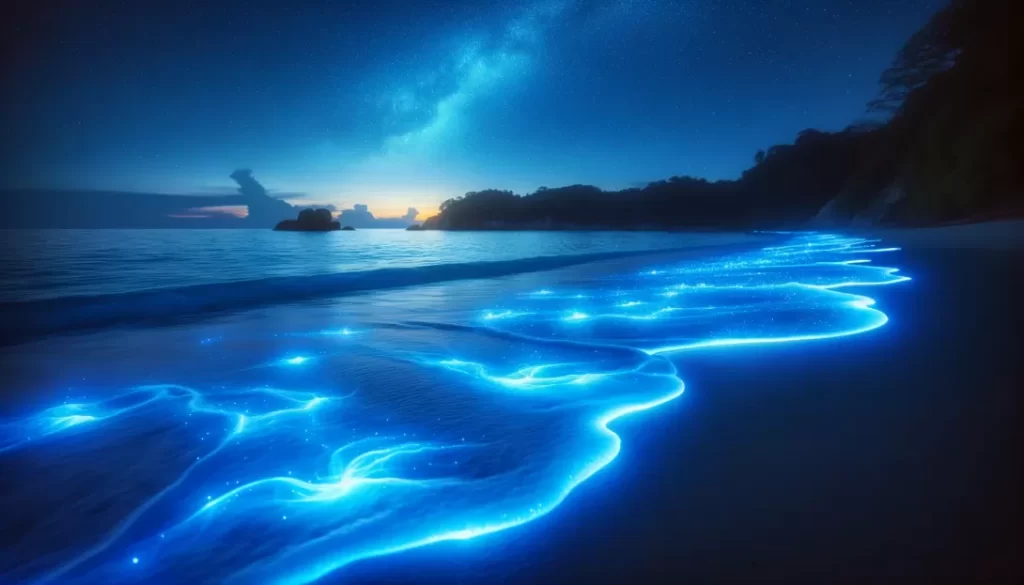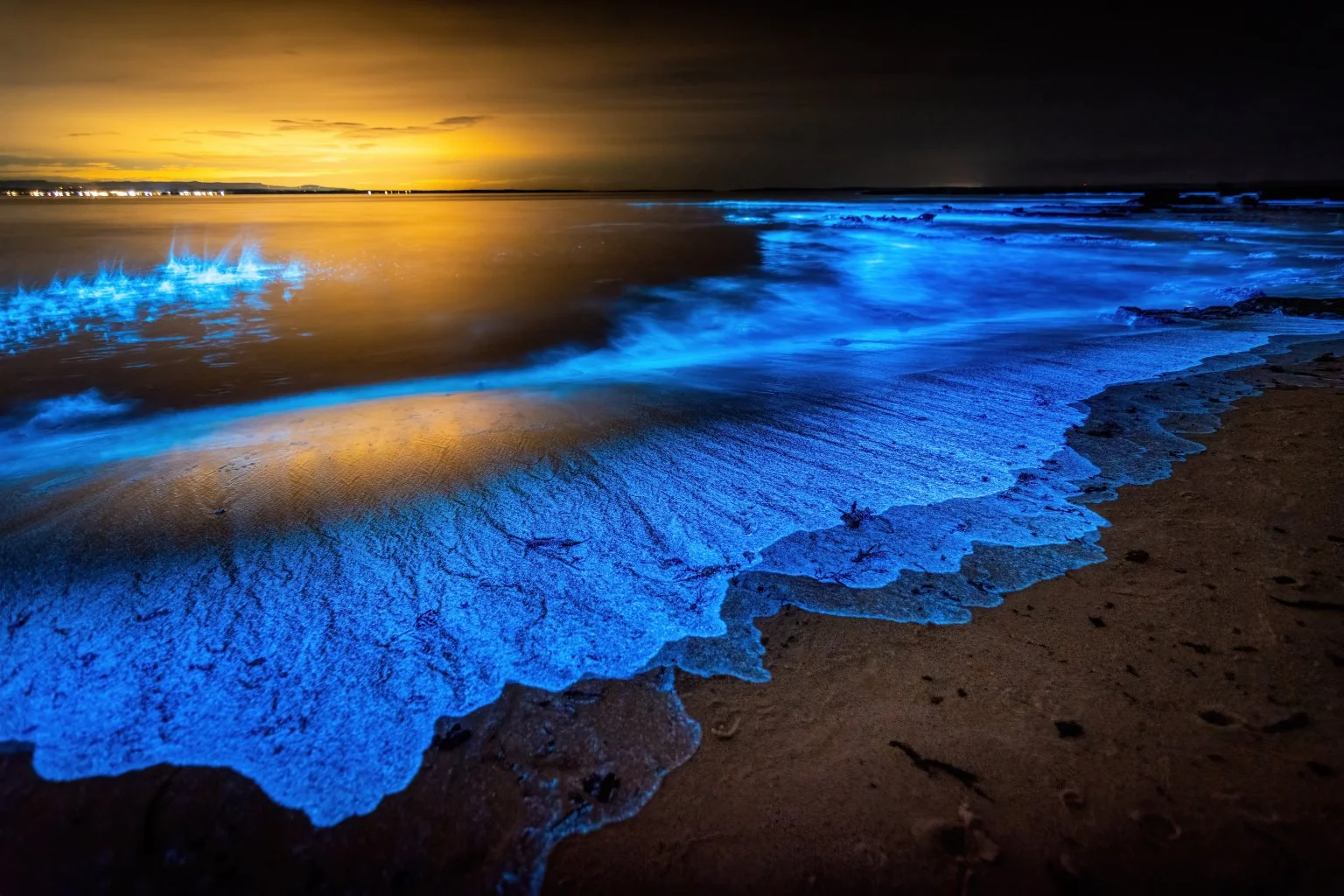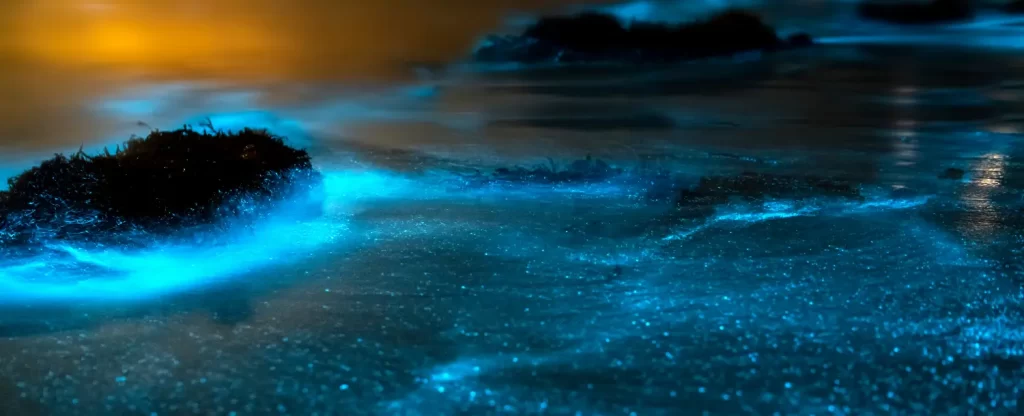List Of Contents
- 1 The Science Behind Deep Ocean Bioluminescence
- 2
- 3 The Importance of Deep Ocean Bioluminescence in Ecosystems
- 4 Different Types of Deep Ocean Bioluminescent Organisms
- 5 Adaptations of Deep Ocean Bioluminescent Organisms
- 6 Factors Influencing Deep Ocean Bioluminescence
- 7 Current Research and Discoveries in Deep Ocean Bioluminescence
- 8 The Future of Deep Ocean Bioluminescence Research
- 9 Appreciating the Beauty and Wonder of Deep Ocean Bioluminescence
- 10 Author
Deep beneath the veils of the ocean’s darkness, there lies a spectacle that brings light to the night through an otherworldly glow. The scientific term for “the ability of organisms to produce light” has fascinated the minds of scientists and international audiences for countless centuries. In this comprehensive article, let us investigate the secrets of deep ocean bioluminescence and uncover the multiple facets of this phenomenon.
From enigmatic beings defying physics as they shroud the darkest corners of the deep in an otherworldly glow to a wave shimmering under the moonlight as it crashes to the sandy shore, bioluminescence undoubtedly stands as one of the most miraculous acts of nature. Each flicker serves as a reminder of chemical dances and symbiotic cascades taking place in a microscopic world we are yet to uncover. Exploring the incredible adaptations and biological mechanisms behind bioluminescent organisms offers a fascinating insight into how nature adapted to capitalize on the power of light. From single-celled plankton to gigantic mammals gliding through the uncharted abyss, each creature has developed a unique and astonishing way to use light.
The Science Behind Deep Ocean Bioluminescence
Deep ocean bioluminescence is the marveling phenomenon that has both the public and scientist trying to comprehend the process behind the glowing. It is the generation of light by living organism. The light manifests as a result of a chemical reaction that involves the mediation of specific molecules and enzymes. One of the widely established chemistry of this reaction is the combination of a molecule known as luciferin and an enzyme known as luciferase.
Luciferin, upon oxidation by luciferase, releases energy in the form of light. This reaction is known as the bioluminescent reaction. Deep ocean bioluminescent organisms have developed highly sophisticated chemistries to mediate, control, and regulate such reactions. The organism is well equipped with cells or specialized organs known as photophores that contain the enzymes and the molecules in conditions suitable for light generation. The photophores are distributed in various parts of the body to generate light in a flash or pattern. The organism emit light of various colors and intensities. Some organism will emit varying colors from blue, green, and red to yellow. The function of light in bioluminescence ranges from communication to adjacent organisms and attraction of prey or mates.
The Importance of Deep Ocean Bioluminescence in Ecosystems
Deep ocean bioluminescence plays a crucial role in the functioning of marine ecosystems. It acts as a key component of the intricate web of interactions among organisms and their environment. The emitted light serves as a language that facilitates communication and coordination between species.
One of the most important functions of bioluminescence is predator deterrence. Many deep-sea organisms emit light when they are threatened or disturbed, creating a bright flash that startles and confuses potential predators. This defensive mechanism provides the organisms with a chance to escape from their predators and avoid being eaten.
Bioluminescence also plays a vital role in attracting prey. Some deep-sea organisms emit light to lure their prey towards them. The emitted light acts as a beacon, attracting smaller organisms that are attracted to the brightness. Once the prey is close enough, the predator strikes, capturing its meal with precision.
Additionally, bioluminescence is often used for mate attraction and courtship displays. Some deep-sea organisms emit light in specific patterns or sequences to signal their availability and attract potential mates. This intricate dance of light serves as a form of communication between individuals of the same species, ensuring successful reproduction.
Different Types of Deep Ocean Bioluminescent Organisms
Deep ocean bioluminescence is not limited to a specific group of organisms but is found in a wide range of species across different taxonomic groups. From microscopic plankton to large marine mammals, the ability to produce light is widespread in the deep ocean.
One of the most well-known examples of bioluminescent organisms is the dinoflagellates. These microscopic planktonic organisms are abundant in the world’s oceans and are responsible for the mesmerizing phenomenon of bioluminescent waves. When disturbed, the dinoflagellates emit light, creating a stunning display of glowing waves that light up the night.
Another group of bioluminescent organisms found in the deep ocean is the anglerfish. These bizarre-looking creatures have a long, thin filament protruding from their head, which acts as a lure to attract prey. The tip of the filament contains a bioluminescent organ that emits light, attracting smaller fish towards the anglerfish. Once the prey is close enough, the anglerfish strikes with lightning speed, capturing its meal.
Deep-sea jellyfish, known as comb jellies, are also bioluminescent. These gelatinous creatures possess rows of tiny cilia that produce a shimmering, iridescent light. The bioluminescent display acts as both a defense mechanism and a way to attract prey. The comb jellies use their light-producing abilities to startle predators and to lure small organisms towards their tentacles.
Adaptations of Deep Ocean Bioluminescent Organisms
The deep ocean has one of the most challenging environments on Earth, characterized by harsh conditions and almost complete darkness, high pressure, low temperatures, and food scarcity. Thus, bioluminescent organisms in the deep sea have developed numerous adaptations to flourish in such a hostile abode.
Primarily, deep-sea organisms gained the ability to control the intensity and duration . They have evolved specialized mechanisms to control the production of light and its emission, which helps them regulate energy expenditure and reduce the risks of unwanted attraction. Some even evolved the ability to change the focus of the light produced – for instance, deep-sea shrimp can emit red light, which is less visible to predators and prey and thus safer for stealth and survival.
Another crucial adaptation is the capacity to produce light without generating heat. Bioluminescence in deep-sea organisms is not accompanied by a significant temperature increase, like artificial light created by humans, which is key to survival in the environment where body temperature regulation is essential. Additionally, some deep-sea organisms developed symbiotic relationships with bioluminescent bacteria. These organisms evolved specialized light organs hosting bioluminescent bacteria that produce light due to chemical reactions, which host organisms can use for their benefit. The bacteria, in turn, gain protection and ingested nutrients from the host.
Factors Influencing Deep Ocean Bioluminescence
Several factors influence the occurrence and intensity of deep ocean bioluminescence. One of the most important factors is depth. As we descend further into the depths of the ocean, the amount of bioluminescence increases. This is because many deep-sea organisms rely on bioluminescence to survive and reproduce in the complete darkness of the deep ocean.
Water temperature also plays a role in deep ocean bioluminescence. Some organisms are more active and produce more light in warmer waters, while others thrive in colder temperatures. The availability of nutrients and prey also affects bioluminescence. Areas with high nutrient concentrations often have a higher density of bioluminescent organisms, as they have more food resources to support their energy-intensive light production.
Additionally, bioluminescence can be influenced by external factors such as pollution and human activities. Pollution can interfere with the biological processes and chemical reactions involved in bioluminescence, leading to a decrease in light production. Human activities, such as underwater exploration and fishing, can disrupt the natural habitats of bioluminescent organisms, affecting their populations and overall bioluminescent activity.

Current Research and Discoveries in Deep Ocean Bioluminescence
In conclusion, the study of deep ocean bioluminescence is a rapidly developing field. Scientists are only beginning to learn the many facets of this phenomenon and make new and exciting discoveries. Recent technological advancements have made it possible to explore deep-sea environments in greater detail, to draw organisms where they are found and observe their behavior. Multiple areas have garnered attention. The first area of investigation is uncovering the genetic basis of jpslot.
By examining the molecular mechanisms associated with light production, researchers can cultivate a clearer understanding of how many different organisms evolved from a common ancestor. They can also use this knowledge to infer the ecological function of bioluminescence, and its evolutionary relationship with other traits. The second area of study is understanding the potential applications of bioluminescence. Bioluminescent creatures generate little or no heat from their light, giving researchers another way to explore imaging and diagnostic technology. With many human activities threatening to impact the functioning of deep-sea organisms, the third opportunity area is to understand what will happen if the ocean’s bioluminescence changes.
The Future of Deep Ocean Bioluminescence Research
Luckily, the future of deep ocean bioluminescence research looks bright. With the increasing development of technology and the world’s growing interest in our oceans scientists are likely to uncover more secrets and study deep ocean bioluminescence in more detail. Advanced imaging technologies, new genome sequencing techniques, and genetic editing methods are only a few new tools that will help scientists study bioluminescent organisms in detail, and new advancements in technology are likely to appear in the future . For example, the examination of different species’ genomes huge insights regarding the genetic basis of bioluminescence and its evolution.
However, discovering the bioluminescent organisms’ secrets will be impossible without interdisciplinary collaboration between biologists, chemists, physicists, and engineers. By combining the knowledge and skills of scientists from different fields, it is likely to develop new approaches to studying, creating, and harnessing bioluminescence. Additionally, as people become more and more aware of the unique nature and the importance of deep-sea ecosystems, the conservation of the deep ocean bioluminescent organisms is also likely to gain momentum . compigne collaborative effortswill focus on protecting deep-sea ecosystems by developing s that target actual threats and promote sustainable behavior among humans.
Appreciating the Beauty and Wonder of Deep Ocean Bioluminescence
Deep ocean bioluminescence is a breathtaking natural spectacle that continues to captivate and inspire. From the ethereal glow of bioluminescent waves to the mesmerizing displays of deep-sea creatures, the secrets of bioluminescence are gradually being unlocked, revealing the intricate mechanisms and vital roles of these organisms.
By delving into the science behind deep ocean bioluminescence, understanding its importance in marine ecosystems, and exploring the adaptations and factors influencing bioluminescence, we gain a deeper appreciation for the beauty and wonder of the deep ocean.
As research in deep ocean bioluminescence progresses, we stand to gain valuable knowledge that can inform conservation efforts and inspire technological innovations. By protecting and preserving the delicate balance of deep-sea ecosystems, we ensure that future generations can continue to marvel at the hidden wonders that lie beneath the surface of our vast oceans.
So, let us embark on this extraordinary journey, as we unlock the secrets of deep ocean bioluminescence and bask in the awe-inspiring glow of nature’s most captivating spectacle.


